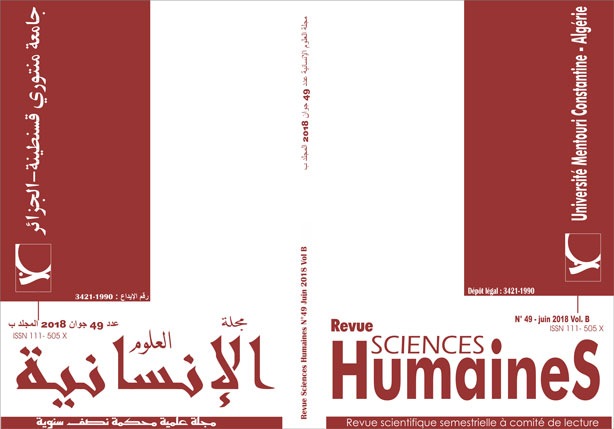An Investigation of Foreign Language Learners’ Problems in Intercultural Communication
الكلمات المفتاحية:
Language، culture، cross-cultural communication، social media، language learningالملخص
The present paper strives to highlight the relationship between language and culture in communication, in addition to the role religion may play in the activity for some nations, particularly Arab nations and Islam. It investigates specifically the strategies and problems of a sample of Algerian students of English at the University of Oum El Bouaghi while interacting with native speakers through social media.It focuses on the significance of cultural awareness in intercultural communication and attempts to shed light on the reasons behind students’ communication breakdowns. The results show that despite the students’ rather advanced level of English language proficiency, they still find problems in intercultural communication mainly due to cultural differences. Therefore, the integration of a course in cross-cultural communication in language teaching curricula is highly recommended where research in the area should in no way be estranged from the pedagogical practice.
التنزيلات
المراجع
Abu Rass, R. (2011). Cultural transfer as an obstacle for writing well in English: The Case of Arabic speakers writing in English. English Language Teaching, 4(2), 206-212.
An, Y. J., Aworuwa, B., Ballard, G., & Williams, K. (2009). Teaching with Web 2.0 technologies: Benefits, barriers and best practices. In M. Simonson (Ed.), Selected research and development papers presented at the 32nd annual convention of the Association for Educational Communications and Technology (pp. 1-6). Louisville: AECT.
Brown, H. D. (2000). Principles of language teaching and learning (4th ed.). White Plains, NY: Longman.
Chen, H.-I. (2013). Identity practices of multilingual writers in social networking spaces. Language Learning & Technology, 17(2), 143-170. Retrieved from: http://llt.msu.edu/issues/june2013/chen.pdf
Elmes, D. (2013). The relationship between language and culture. National Institute of Fitness and Sports in Kanoya Scholarly Research Bulletin, 46, 11-18. Retrieved from: www2.lib.nifs-k.ac.jp/HPBU/annals/an46/46-11.pdf
Derakhshan, A., & Hasanabbasi, S. (2015). Social networks for language learning. Theory and Practice in Language Studies, 5(5), 1090-1095.
Jiang, W. (2000). The relationship between culture and language. ELT Journal, 54(4), 328-334.
Kaplan, R. B. (1966). Cultural thought patterns in intercultural education. Language Learning, 16, 1–20.
Lin, C.-H., Warschauer, M., & Blake, R. (2016). Language learning through social networks: Perceptions and reality. Language Learning & Technology, 20(1), 124–147. Retrieved from: http://llt.msu.edu/issues/february2016/linwarschauerblake.pdf
Lomicka, L., & Lord, G. (2016). Social networking and language learning. In F. Farr & L. Murray (Eds.), The routledge handbook of language learning and technology (pp. 255-268). New York: Routledge.
Malerba, M. L. (2016). Social networking and informal second language learning in Livemocha and Busuu online communities. European Journal of Open, Distance and E-learning, 19(2). Retrieved from: http://www.eurodl.org/?p=special&sp=articles&inum=8&article=731
Mc Dermott, G. (2013). The role of social media in foreign language teaching: A case study for French. Recherche et Pratiques Pédagogiques en Langues de Spécialité, 32(2), 141-157.
McBride, K. (2009). Social-networking sites in foreign language classes: Opportunities for re-creation. In L. Lomicka & G. Lord (Eds.), The next generation: Social networking and online collaboration in foreign language learning (pp. 35-58). San Marcos, Texas: CALICO.
Merrouche, S. (2010). Approaches to culture in foreign language teaching. Revue Sciences Humaines, 33, 103-114.
Mitchell, K. (2012). A social tool: Why and how ESOL students use Facebook. CALICO Journal, 29(3), 471–493.
Qaddumi, M. K. H. (1995). Textual deviation and coherence problems in the writings of Arab students at the University of Bahrain: Sources and solutions. Unpublished doctoral dissertation. University of Nottingham: Nottingham, UK.
Risager, K. (2005), Languaculture as a key concept in language and culture teaching. In B. Preisler, A. Fabricius, H. Haberland, S. Kjærbeck, & K. Risager (Eds.), The consequences of mobility: Linguistic and sociocultural contact zones (pp. 185-196). Roskilde, Denmark: Roskilde Universitet.
Sawyer, R. (2011). The impact of new social media on intercultural adaptation. Senior Honors Projects, Paper 242. Retrieved from: http://digitalcommons.uri.edu/srhonorsprog/242
Vie, S. E. (2007). Engaging others in online social networking sites: Rhetorical practices in MySpace and Facebook. Unpublished doctoral dissertation. University of Arizona, Tucson, AZ.
Whorf, B. J. (1956). Language, thought and reality: Selected writings of Benjamin Lee Whorf. USA: Massachusetts Institute of Technology and John Wiley & Sons, Inc.
Yule, G. (1996). Pragmatics. Oxford: Oxford University Press.
















